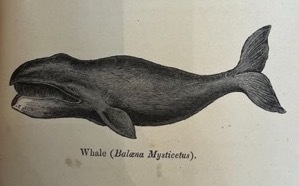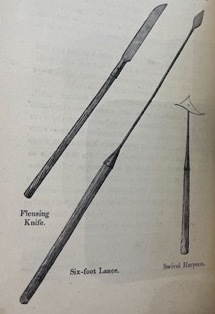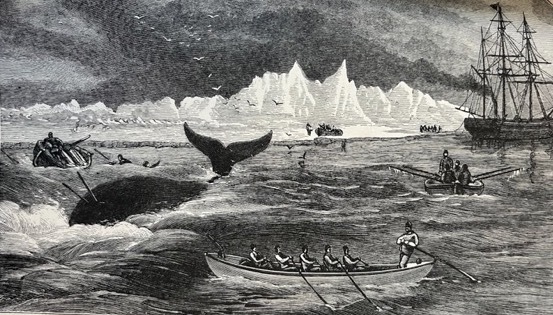Western Fishing and Hunting
A major driver for European exploration into the Arctic was the whaling industry. Whales are very profitable creatures that produce a variety of substances, including meat, oil, bone, and blubber. Thus, they were very enticing to profit-driven European merchants.
The Dutch were the first Europeans to successfully hunt whales. They had a huge fleet, up to almost 1500 boats. However, they were not very efficient, as each boat only captured around 3-4 whales each season. This was profitable enough while not threatening to deplete the supply of whales in the area.
In later decades, English whalers began to join the Dutch. As the industry grew, its technology became more advanced, and ships were able to take more and more whales at a time. One particularly successful English captain, William Scoresby, managed to take nearly 100 whales in 5 short years. In short, whales were quickly exploited by Europeans.
In his book A Whaling Cruise to Baffin’s Bay and the Gulf of Boothia, Commander A.H. Markham describes in detail the process of catching a whale. Once the crew spots their target, they lower boats filled with men armed with harpoons in an attempt to chase the creature. Some boats drive their harpoons (see “swivel harpoon” in image) into the body of the whale. Remaining boats hold lances (see “six-foot lance” in image) ready to deliver the “coup de grâce,” the French term for a final strike to kill the animal.
Once the animal is dead, the boats return to the main ship to prepare for the next stage: “fliching,” or taking its blubber. First, the men must cut a hole through each fin and bind them together, allowing the whale to swiftly be towed through the water without excess drag. The whale is then dragged by its tail to the port side of the ship, where it is secured so that men are able to cut blubber from its body using blubber spades and knives (see “flensing knife” in image). Next, they hoisted the chunks of blubber on board, which was difficult considering they could weigh up to 1-2 tons apiece. This process is supervised by the captain, who watches and directs all activity from the port main rigging.
Once everything considered valuable has been transferred on board, the men release the carcass into the water, with men cheering as the ocean water turns red with blood. Those on board are left with the responsibility of cutting the large pieces of blubber into pieces about two square feet in size with long knives. These pieces are then stored below deck to be brought back to the mainland.
Left unchecked, whalers can force such valuable species to extinction. Over time, whaling policies have been developed to protect the mammals from being over-hunted. For Greenland, which is the most relevant to Baffin Bay, the International Whaling Commission implements strict quotas for whalers. This limit is supposed to satisfy Greenland’s local “nutritional and cultural need,” but this definition has been stretched as whale meat is also being sold to tourists. As seen by previous European expeditions, whales are precious sources of many valuable substances and are thus tempting to exploit. However, in order to preserve the species and allow future generations to also pursue the whaling industry, strict and enforced regulation is more necessary than ever.
Additional Sources:
https://www.scran.ac.uk/packs/exhibitions/learning_materials/webs/40/origins.htm



